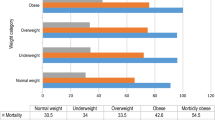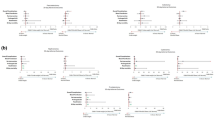Abstract
Background
Obesity is an increasingly common serious chronic health condition. We sought to determine the impact of body mass index (BMI) on perioperative outcomes in patients undergoing major intra-abdominal cancer surgery.
Methods
A prospective, multi-institutional, risk-adjusted cohort study of patients undergoing major intra-abdominal cancer surgery was performed from the 14 university hospitals participating in the Patient Safety in Surgery Study of the National Surgical Quality Improvement Program (NSQIP). Demographic, clinical, and intraoperative variables and 30-day morbidity and mortality were prospectively collected in standardized fashion. Analysis of variance, Bonferroni multiple comparisons of means tests, and multivariable logistic regression analysis were performed.
Results
We identified 2258 patients who underwent esophagectomy (n = 29), gastrectomy (n = 223), hepatectomy (n = 554), pancreatectomy (n = 699), or low anterior resection/proctectomy (n = 753). Patients were stratified by National Institutes of Health (NIH)-defined BMI obesity class, with 573 (25.4%) patients classified as obese (BMI > 30 kg/m2). There were no differences in mean work relative value units, total time of operation, or length of stay amongst the BMI classes. After adjusting for other risk factors, obesity was not a risk factor for death or major complications but was a risk factor for wound complications. The risk of postoperative death was greatest in underweight patients (odds ratio [OR] 5.24; 95% confidence interval [CI] 1.7–16.2).
Conclusion
In patients undergoing major intra-abdominal cancer surgery, obesity is not a risk factor for postoperative mortality or major complications. Importantly, underweight patients have a fivefold increased risk of postoperative mortality, perhaps a consequence of their underlying nutritional status.

Similar content being viewed by others
References
Ogden CL, Carroll MD, Curtin LR, et al. Prevalence of overweight and obesity in the United States, 1999–2004. JAMA 2006; 295:1549–55
Larsson SC, Orsini N, Wolk A. Body mass index and pancreatic cancer risk: a meta-analysis of prospective studies. Int J Cancer 2007; 120:1993–8
Renehan AG, Tyson M, Egger M, et al. Body-mass index and incidence of cancer: a systematic review and meta-analysis of prospective observational studies. Lancet 2008; 371:569–78
Adams KF, Schatzkin A, Harris TB, et al. Overweight, obesity, and mortality in a large prospective cohort of persons 50 to 71 years old. N Engl J Med 2006; 355:763–78
Finkelstein EA, Fiebelkorn IC, Wang G. National medical spending attributable to overweight and obesity: how much, and who’s paying? Health Aff (Millwood) 2003; Suppl Web Exclusives:W3-219-226
Hawn MT, Bian J, Leeth RR, et al. Impact of obesity on resource utilization for general surgical procedures. Ann Surg 2005; 241:821–6; discussion 826–8
Lee CT, Dunn RL, Chen BT, et al. Impact of body mass index on radical cystectomy. J Urol 2004; 172:1281–5
Prem KA, Mensheha N, McKelvey JL. Operative treatment of adenocarcinoma of the endometrium in obese women. Am J Obstet Gynecol 1965; 92:16–22
Fasol R, Schindler M, Schumacher B, et al. The influence of obesity on perioperative morbidity: retrospective study of 502 aortocoronary bypass operations. Thorac Cardiovasc Surg 1992; 40:126–9
Holley JL, Shapiro R, Lopatin WB, et al. Obesity as a risk factor following cadaveric renal transplantation. Transplantation 1990; 49:387–9
Chapman GW Jr, Mailhes JB, Thompson HE. Morbidity in obese and nonobese patients following gynecologic surgery for cancer. J Natl Med Assoc 1988; 80:417–20
Foley K, Lee RB. Surgical complications of obese patients with endometrial carcinoma. Gynecol Oncol 1990; 39:171–4
Jiganti JJ, Goldstein WM, Williams CS. A comparison of the perioperative morbidity in total joint arthroplasty in the obese and nonobese patient. Clin Orthop Relat Res 1993; 175–9
Stern SH, Insall JN. Total knee arthroplasty in obese patients. J Bone Joint Surg Am 1990; 72:1400–4
Vinton AL, Traverso LW, Jolly PC. Wound complications after modified radical mastectomy compared with tylectomy with axillary lymph node dissection. Am J Surg 1991;161:584–8
Thomas EJ, Goldman L, Mangione CM, et al. Body mass index as a correlate of postoperative complications and resource utilization. Am J Med 1997; 102:277–83
Klasen J, Junger A, Hartmann B, et al. Increased body mass index and peri-operative risk in patients undergoing non-cardiac surgery. Obes Surg 2004; 14:275–81
Dindo D, Muller MK, Weber M, et al. Obesity in general elective surgery. Lancet 2003; 361:2032–5
Kodera Y, Ito S, Yamamura Y, et al. Obesity and outcome of distal gastrectomy with D2 lymphadenectomy for carcinoma. Hepatogastroenterology 2004; 51:1225–8
House MG, Fong Y, Arnaoutakis DJ, et al. Preoperative predictors for complications after pancreaticoduodenectomy: impact of BMI and body fat distribution. J Gastrointest Surg 2008; 12:270–8
Khuri SF, Henderson WG, Daley J, et al. The patient safety in surgery study: background, study design, and patient populations. J Am Coll Surg 2007; 204:1089–102
Daley J, Khuri SF, Henderson W, et al. Risk adjustment of the postoperative morbidity rate for the comparative assessment of the quality of surgical care: results of the National Veterans Affairs Surgical Risk Study. J Am Coll Surg 1997; 185:328–40
Khuri SF, Daley J, Henderson W, et al. The Department of Veterans Affairs’NSQIP: the first national, validated, outcome-based, risk-adjusted, and peer-controlled program for the measurement and enhancement of the quality of surgical care. National VA Surgical Quality Improvement Program. Ann Surg 1998; 228:491–507
Khuri SF, Daley J, Henderson W, et al. Risk adjustment of the postoperative mortality rate for the comparative assessment of the quality of surgical care: results of the National Veterans Affairs Surgical Risk Study. J Am Coll Surg 1997; 185:315–27
Calle EE, Rodriguez C, Walker-Thurmond K, et al. Overweight, obesity, and mortality from cancer in a prospectively studied cohort of U.S. adults. N Engl J Med 2003; 348:1625–38
Calle EE, Thun MJ, Petrelli JM, et al. Body-mass index and mortality in a prospective cohort of U.S. adults. N Engl J Med 1999; 341:1097–105
Patel N, Bagan B, Vadera S, et al. Obesity and spine surgery: relation to perioperative complications. J Neurosurg Spine 2007; 6:291–7
Benoist S, Panis Y, Alves A, et al. Impact of obesity on surgical outcomes after colorectal resection. Am J Surg 2000; 179:275–81
Blee TH, Belzer GE, Lambert PJ. Obesity: is there an increase in perioperative complications in those undergoing elective colon and rectal resection for carcinoma? Am Surg 2002; 68:163–6
Moulton MJ, Creswell LL, Mackey ME, et al. Obesity is not a risk factor for significant adverse outcomes after cardiac surgery. Circulation 1996; 94:II87–92
Pemberton LB, Manax WG. Relationship of obesity to postoperative complications after cholecystectomy. Am J Surg 1971; 121:87–90
Perka C, Labs K, Muschik M, et al. The influence of obesity on perioperative morbidity and mortality in revision total hip arthroplasty. Arch Orthop Trauma Surg 2000; 120:267–71
Postlethwait RW, Johnson WD. Complications following surgery for duodenal ulcer in obese patients. Arch Surg 1972; 105:438–40
Perioperative total parenteral nutrition in surgical patients. The Veterans Affairs Total Parenteral Nutrition Cooperative Study Group. N Engl J Med 1991; 325:525–32
Gibbs J, Cull W, Henderson W, et al. Preoperative serum albumin level as a predictor of operative mortality and morbidity: results from the National VA Surgical Risk Study. Arch Surg 1999; 134:36–42
Palma S, Cosano A, Mariscal M, et al. Cholesterol and serum albumin as risk factors for death in patients undergoing general surgery. Br J Surg 2007; 94:369–75
Winter JM, Cameron JL, Yeo CJ, et al. Biochemical markers predict morbidity and mortality after pancreaticoduodenectomy. J Am Coll Surg 2007; 204:1029–36; discussion 1037–8
Inui A. Cancer anorexia-cachexia syndrome: current issues in research and management. CA Cancer J Clin 2002; 52:72–91
Bozzetti F, Pagnoni AM, Del Vecchio M. Excessive caloric expenditure as a cause of malnutrition in patients with cancer. Surg Gynecol Obstet 1980; 150:229–34
Knox LS, Crosby LO, Feurer ID, et al. Energy expenditure in malnourished cancer patients. Ann Surg 1983; 197:152–62
Bozzetti F, Gavazzi C, Miceli R, et al. Perioperative total parenteral nutrition in malnourished, gastrointestinal cancer patients: a randomized, clinical trial. JPEN J Parenter Enteral Nutr 2000; 24:7–14
Braga M, Gianotti L, Nespoli L, et al. Nutritional approach in malnourished surgical patients: a prospective randomized study. Arch Surg 2002; 137:174–80
O’Brien JM Jr, Phillips GS, Ali NA, et al. Body mass index is independently associated with hospital mortality in mechanically ventilated adults with acute lung injury. Crit Care Med 2006; 34:738–44
Tremblay A, Bandi V. Impact of body mass index on outcomes following critical care. Chest 2003; 123:120–7
Curtis JP, Selter JG, Wang Y, et al. The obesity paradox: body mass index and outcomes in patients with heart failure. Arch Intern Med 2005; 165:55–61
Gruberg L, Weissman NJ, Waksman R, et al. The impact of obesity on the short-term and long-term outcomes after percutaneous coronary intervention: the obesity paradox? J Am Coll Cardiol 2002; 39:578–84
Gurm HS, Brennan DM, Booth J, et al. Impact of body mass index on outcome after percutaneous coronary intervention (the obesity paradox). Am J Cardiol 2002; 90:42–5
Hotamisligil GS. Inflammation and metabolic disorders. Nature 2006; 444:860–7
Gil A, Maria Aguilera C, Gil-Campos M, et al. Altered signalling and gene expression associated with the immune system and the inflammatory response in obesity. Br J Nutr 2007; 98 Suppl 1:S121–6
Cheymol G. Effects of obesity on pharmacokinetics implications for drug therapy. Clin Pharmacokinet 2000; 39:215–31
Pai MP, Bearden DT. Antimicrobial dosing considerations in obese adult patients. Pharmacotherapy 2007; 27:1081–91
Author information
Authors and Affiliations
Corresponding author
Rights and permissions
About this article
Cite this article
Mullen, J.T., Davenport, D.L., Hutter, M.M. et al. Impact of Body Mass Index on Perioperative Outcomes in Patients Undergoing Major Intra-abdominal Cancer Surgery. Ann Surg Oncol 15, 2164–2172 (2008). https://doi.org/10.1245/s10434-008-9990-2
Received:
Revised:
Accepted:
Published:
Issue Date:
DOI: https://doi.org/10.1245/s10434-008-9990-2




